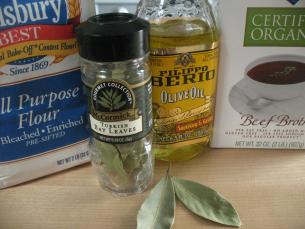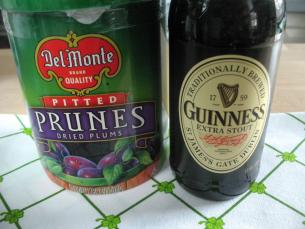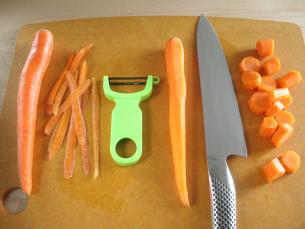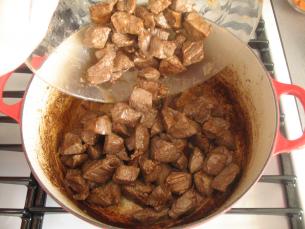
Guinness Stout Beef Stew is rich and hearty and a perfect meal to serve on a cold day. Of course, it’s a must for St Patrick’s Day, which here in Boston is a huge celebration!
You can serve this stew for Sunday lunch and then, late in the day, try some of startcooking.com’s Irish Bread with Irish Coffee.

The fresh ingredients you will need to make this stew are garlic, onion, carrots, stew beef and parsley for the garnish (decoration.) Buy the most tender stew beef you can afford. (Ask the butcher!) This stew takes only 1 and 1/2 hours to cook so you need a tender stew beef-“round” stew beef works well for this recipe. (For stews that take 3-4 hours to cook, it’s OK to use a less tender cut of beef, like beef chuck.)

From the pantry, you will need white flour, oil, beef broth and bay leaves. Remember to remove the bay leaf before serving!

You will also need pitted prunes along with the Guinness Stout.

Before we startcooking, a few words of caution:
First, do not omit the prunes! Without the prunes, the Guinness is going to make the stew taste bitter. The prunes cook down and melt into the stew. If you don’t tell, no one will even be aware that they are in this stew! (Do you see them in the photo below?)

Second, do not replace the “Extra Stout” with “draught” or with those bottles of Guinness with the widgets in them that make the foam. The taste will be all wrong!
****
Begin by getting the carrots, onions, garlic and beef all cut up and ready to cook.
Peel the carrots and cut them into chunky slices about 1/2 inch thick.
(The picture below shows, from left to right, the stages and equipement I use to turn a whole carrot into the slices.)

Chop the onion.

Crush the garlic.

Cut the stew beef into approximately 1 inch chunks.

In a large, heavy, Dutch oven, set on medium high; heat the oil and sauté (fry) the onions for about 3-4 minutes.

Add the garlic and continue cooking for another 30 seconds.

Remove the onions and garlic from the pot.

The meat needs to get “seared” in small batches. It is very tempting to add half the meat thinking “well that fits into a single layer in the pot…so why not?”

The photo below is why not! If you overcrowd the pan the meat will get foamy and bubbly, and not develop a nice rich browned color.

Small batches….

…will guarantee a nicely browned meat.

Remove the meat from the pan….

…and add the next batch.

When all the meat is browned, add it all back to the pot.

Sprinkle on the flour.

Reduce the heat to simmer, stir in the flour until all the meat is coated

Add beef broth……

…and Guinness (Extra Stout only!)

…and stir everything until mixture comes to a simmer.
Now add the onions, garlic, carrots and the bay leaves. (Be sure to remove the bay leaves before you serve the stew. They are there to impart flavor but you do not eat bay leaves.)

Give everything a stir.

The beer/broth should cover all the ingredients. If it does not, you may need to add a bit more broth.

Simmer the stew gently, uncovered, for one hour. (There should only be tiny little bubbles with the occasional waft of steam coming from the stew.) Be sure to give it an occasional stir.
While the stew is simmering, chop the prunes.

Add the prunes….

…and continue cooking the stew for another 1/2 hour.

The prunes will “melt” into the stew and the gravy will develop a wonderful rich flavor and have a nice glossy finish.

Boiled or mashed potatoes garnished with chopped parsley
are perfect to serve with this stew. Don’t forget to remove the bay leaves!

Cheers!
If you are new to startcooking, or are a regular visitor here, please consider subscribing for free.









































John Ellerbrock said:
Kathy – the Guiness Stout Beef Stew looks great and I would like to make it for Sunday – one day before St. Patrick’s. Some of my guests cannot take alcohol so I’m wondering if it will ‘cook away’ leaving only the taste.
Many thanks,
John